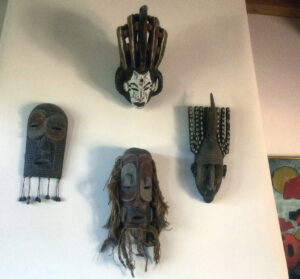Masks of the Zaire Region
 KMcD sent me a photo of four African masks purchased in Tanzania and Kenya, originally from Zaire, the Congo. I love these masks because I spent two years in upper Nigeria and the Ivory Coast with the VSO, the British version of the Peace Corps. I treasure my mask from the Ivory Coast, a wisdom mask, worn by young men at puberty rites. The mask shows a female spirit on the forehead in the shape of a bird that faces downward to the bridge of the nose. Since I raised a male I relate to this mask, acquired in my early twenties, before I became a mother.
KMcD sent me a photo of four African masks purchased in Tanzania and Kenya, originally from Zaire, the Congo. I love these masks because I spent two years in upper Nigeria and the Ivory Coast with the VSO, the British version of the Peace Corps. I treasure my mask from the Ivory Coast, a wisdom mask, worn by young men at puberty rites. The mask shows a female spirit on the forehead in the shape of a bird that faces downward to the bridge of the nose. Since I raised a male I relate to this mask, acquired in my early twenties, before I became a mother.
Only one art form in three dimensions contains many worlds within its shape, color, and design—the mask. Especially in Africa it holds specific symbolic meaning to a specific geographical culture. Before I tell you about the four masks KMcD sent, which date from the 1920s -1930s, I offer my thoughts on their importance.
Cultural and Spiritual Dimension of MasksThe mask offers connection with the ancestors, both on a cultural and spiritual dimension. They’re worn and “danced” as part of the human body, and body politic, at festivals, initiations, funerals, marriages, and in rites of passage such as coming into manhood or womanhood. Masks taught society’s myths, building a common language. The ‘danced’ stories and offered protection against evil, bad luck, and illness, and scare and shame. Masks signaled rank in a community and distinguished one cultural group from another.
In the past Eurocentric history of the world we ‘demoted’ masks to the department of cultural anthropology. Only recently, since 20th century artists like Picasso and Klee, who loved African masks, that we know them as fine art. Without understanding their ritual role, we don’t understand. It’s difficult to describe a “static” mask in a museum case, as it’s NOT “danced” or moved as part of a ritual in action.
For KMcD, I describe the origin of these four masks. From the Eastern BaPende Tribe (Zaire), called “Songye” painted wood masks; some bear dark patinas, and some with white accents of kaolin clay, molded into facial features. One has the original fiber head and chin surround. At least one is recognizable as a mask from the association called “Kifwebe,” a high ranking men’s group in the BaPende community, a group in charge of the community hierarchy and distribution of wealth. One masks is ‘two color,’ distinctive to the BaPende people of today’s Democratic Republic of the Congo. The Pende people, which number 250,000 today, speak a language called Kipende. They have a cultural division in the communities between the Western and Eastern Pende. They’re related to the Bantu Peoples.
Differing From Other Masking CommunitiesThe Pende organize around extended family groups that descend from the matriarchal ancestors. They don’t idolize a king, for example.
Many Pende live in modern day Angola having left the Congo to follow their Queen in 1620. By 1885 European colonists named the region the Congo Free State. In 1930 the People rebelled against the Belgian colonists. So if these masks could speak, and I imagine they do, they’d tell a story of strife from that period 1920-1930s.
Masks of the Zaire region, known traditionally for their inclusion in initiation rituals, also worn to honor ancestors, shaped in male and female forms, some of which were not “danced,” but honored in a static, sculptural (statue-style) forms in a pair in a common sacred area of the village.
Anonymous artists who shaped these ancestor masks became close to the spirit of ancestors. So much so that the community honored them and gave them the first food from the harvest.
Thus spirits became embodied in art. The art became a product of a collective endeavor, then a collective ‘performance.’ When danced, the mask enabled the community to focus on a universal and communal message. The community, their ancestors, their past, was celebrated for thousands of years in ritual. Sadly, the mask’s future after 1930s wasn’t the future these masks wanted welcomed. They were traded as souvenirs.
Value of the four masks combined is $2,000-$3,000 with the possibility of a much higher value in the right market.
The post Masks of the Zaire Region appeared first on Elizabeth Appraisals.
Elizabeth Stewart's Blog
- Elizabeth Stewart's profile
- 5 followers



